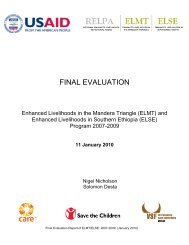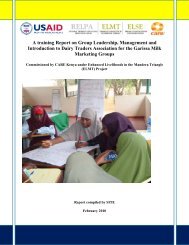Training Module for Community Animal Health Workers in Somalia
Training Module for Community Animal Health Workers in Somalia
Training Module for Community Animal Health Workers in Somalia
You also want an ePaper? Increase the reach of your titles
YUMPU automatically turns print PDFs into web optimized ePapers that Google loves.
Topic: Cl<strong>in</strong>ical Exam<strong>in</strong>ation, Diagnosis and post mortem<br />
Objectives<br />
At the end of the topic, the tra<strong>in</strong>ee should be able to:-<br />
i). Outl<strong>in</strong>e objectives of cl<strong>in</strong>ical exam<strong>in</strong>ations, diagnosis and post-mortem exam<strong>in</strong>ations.<br />
ii). Outl<strong>in</strong>e the process/procedure <strong>for</strong> mak<strong>in</strong>g cl<strong>in</strong>ical exam<strong>in</strong>ations, diagnosis and postmortem<br />
exam<strong>in</strong>ations.<br />
iii). Conduct cl<strong>in</strong>ical exam<strong>in</strong>ations, diagnosis and post-mortem exam<strong>in</strong>ations on an animal.<br />
Suitable Methodology<br />
Practical demonstrations, structured lecture.<br />
Duration: 4 ½ hours.<br />
Materials<br />
<strong>Animal</strong>s <strong>for</strong> cl<strong>in</strong>ical exam<strong>in</strong>ations, diagnosis and post-mortem exam<strong>in</strong>ations, post-mortem kit,<br />
facility <strong>for</strong> physical restra<strong>in</strong>t depend<strong>in</strong>g on animal used <strong>for</strong> demonstration (crutch) other<br />
equipment <strong>for</strong> diagnosis (stethoscope and thermometer).<br />
Content<br />
Objectives of cl<strong>in</strong>ical exam<strong>in</strong>ations, diagnosis and post-mortem exam<strong>in</strong>ations. Procedure and<br />
steps <strong>for</strong> cl<strong>in</strong>ical exam<strong>in</strong>ations, diagnosis and post-mortem exam<strong>in</strong>ations; Note down details of<br />
the animal (<strong>in</strong>clud<strong>in</strong>g owner and location), obta<strong>in</strong><strong>in</strong>g <strong>in</strong><strong>for</strong>mation on history of condition and<br />
management; observation from a distance without touch<strong>in</strong>g; close exam<strong>in</strong>ation <strong>in</strong>volv<strong>in</strong>g touch<strong>in</strong>g<br />
such as feel<strong>in</strong>g pulse, respiration, temperature, digestive movements, test<strong>in</strong>g <strong>for</strong> pa<strong>in</strong> and feel<strong>in</strong>g<br />
<strong>for</strong> swell<strong>in</strong>gs. Further diagnosis <strong>in</strong>volve tak<strong>in</strong>g of samples, laboratory test<strong>in</strong>g and post-mortem<br />
exam<strong>in</strong>ation. Mention reasons <strong>for</strong> go<strong>in</strong>g to subsequent levels.<br />
Topic: Introduction to veter<strong>in</strong>ary Drugs<br />
Objectives<br />
At the end of the topic, the tra<strong>in</strong>ee should be able to:-<br />
i). Describe traditional methods of treatment used <strong>in</strong> the local area.<br />
ii). Give an overview of how drugs work.<br />
iii). List the drugs used <strong>in</strong> modern veter<strong>in</strong>ary treatments, with reference to <strong>Somalia</strong>.<br />
iv). Expla<strong>in</strong> <strong>in</strong> brief, “why modern medic<strong>in</strong>es?”<br />
v). Outl<strong>in</strong>e movement of drugs on the body.<br />
5












